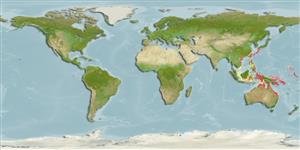Teleostei (teleosts) >
Callionymiformes (Dragonets) >
Callionymidae (Dragonets)
Etymology: Callionymus: Greek, kallion, comparative of kallos = beautiful + Greek, onyma = name; with a better name.
Environment: milieu / climate zone / depth range / distribution range
Ecology
Marine; demersal; depth range 3 - 29 m (Ref. 75992). Tropical
Western Pacific: Papua New Guinea.
Size / Weight / Age
Maturity: Lm ? range ? - ? cm
Max length : 89.1 cm SL male/unsexed; (Ref. 39216)
Dorsal spines (total): 4; Dorsal soft rays (total): 9; Anal soft rays: 8. Head and body light brown, back with small whitish spots, sides with dark blotches and small dark spots. First dorsal fin dusky in males, distal margin blackish, with an elongate black blotch basally on second membrane. First dorsal fin blackish in females, first membrane whitish. Second dorsal fin in males with narrow horizontal streaks, anal fin in males with a distal black streak. Caudal, pectoral, and pelvic fins spotted with brown (Ref 42832).
Life cycle and mating behavior
Maturity | Reproduction | Spawning | Eggs | Fecundity | Larvae
Kailola, P.J., 1987. The fishes of Papua New Guinea: a revised and annotated checklist. Vol. II Scorpaenidae to Callionymidae. Research Bulletin No. 41, Research Section, Dept. of Fisheries and Marine Resources, Papua New Guinea. (Ref. 6192)
IUCN Red List Status (Ref. 130435: Version 2024-1)
Threat to humans
Harmless
Human uses
Tools
Special reports
Download XML
Internet sources
Estimates based on models
Preferred temperature (Ref.
123201): 25.1 - 29.3, mean 28.4 °C (based on 1118 cells).
Phylogenetic diversity index (Ref.
82804): PD
50 = 0.5000 [Uniqueness, from 0.5 = low to 2.0 = high].
Bayesian length-weight: a=0.00891 (0.00410 - 0.01937), b=2.78 (2.60 - 2.96), in cm total length, based on LWR estimates for this Genus-body shape (Ref.
93245).
Trophic level (Ref.
69278): 3.6 ±0.5 se; based on size and trophs of closest relatives
Resilience (Ref.
120179): Very Low, minimum population doubling time more than 14 years (Preliminary K or Fecundity.).
Fishing Vulnerability (Ref.
59153): High to very high vulnerability (65 of 100).
